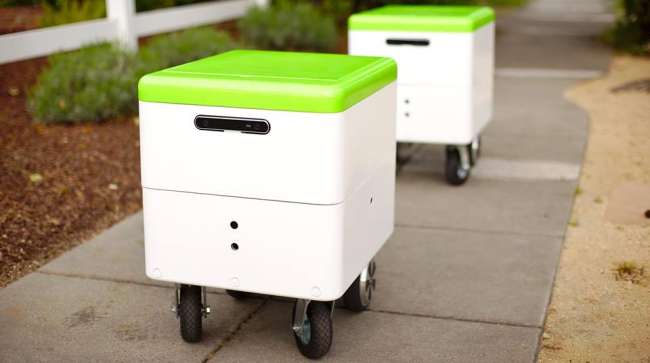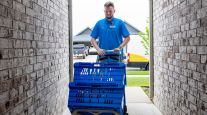Robots Intended to Reduce Cost of ‘Last-Mile’ Deliveries

“You got beer in that thing?” is a common query when Robby the prototype delivery robot navigates the sidewalks of Palo Alto.
That’s to be expected. The little devices do look like ice chests. The kind on wheels that can be towed around a patio at a party.
But the Robby is loaded with advanced technology, ranging from video cameras to ultrasonic sensors to inertial motion devices, and uses artificial intelligence to not only find its way around city streets, but to learn.
Rui Li, one of the co-founders of Robby Technologies, a start-up based in a Palo Alto house not far from the Palo Alto house where Mark Zuckerberg developed Facebook, said the devices use “advanced AI technology so it can react differently to different situations, and learn. It becomes smarter and smarter.”
When does it achieve self-awareness?
Li and Dheera Venkatraman, the other co-founder, laughed at that question without answering, while sitting in a Starbucks on the corner of El Camino Real and Stanford Avenue in Palo Alto on Aug. 28, while their green and white prototype waited patiently in the patio outside.
Robby Technologies is one of three companies that have reached out to the city of Mountain View. Calif., for permission to test robots there. The others are TeleRetail (a German/Swiss company) and Starship Technologies of London, England, which is already testing its devices in Redwood City.
Li said the company wants to try the devices in Mountain View “basically because there are a lot of residences and a high demand for deliveries.” Venkatraman added that Mountain View was also a good choice because it is “a very forward-looking area for technology,” noting the presences already of such tech as Google’s self-driving cars.
But, all three robot companies will have to wait, because Mountain View doesn’t yet have policies in place for delivery robots. The City Council is scheduled to take up the topic at its Sept. 26 meeting.
Li and Venkatraman expect to be at that meeting.
Self-awareness aside, both engineers, who met when earning their Ph.D.s at Massachusetts Institute of Technology, said safety is always a top priority for their robots. In testing, there is always a human being with the devices, and they are also remotely monitored by video.
If a person blocks the path of a Robby, a soft, female voice issues from the robot: “Excuse me.” If the person moves to let the Robby pass, it says “Thank you.” The robot can also change its path to go around an obstacle, or to make room for a pedestrian.
Venkatraman noted that the devices are programmed to show “particular care to children and people in wheelchairs.”
The Robby robots are meant to carry two or three shopping bags worth of goods, from a business to a home. Not from a home to a home, Li and Venkatraman both insisted.
The idea, they said, was to deal with that “last mile” of delivery, which usually accounts for around 30% of the cost of delivery. They said the cost of delivery — now $5 to $10 — could be reduced to $1 or $2.
Li said the robots would create more jobs because they would create more demand for local goods, which would mean more in-store jobs. There would also need to be people monitoring the robots remotely, even when they operate without someone walking along with them, as in tests.
Another benefit of the robots, it was pointed out, is that they can alert authorities to problems with sidewalks. Broken concrete, tree roots, blocked ADA ramps.
The Robby robots are always locked, but the people receiving their deliveries can unlock them using a smart phone. Once out of the prototype stage, they are expected to weigh about 60 pounds.
What if someone tries to sabotage one? Well, responses are built into that artificial intelligence, and they will always be monitored. And can always call the police.
Robby Technologies is funded by seed money from various sources, including Y Combinator. The company’s blurb on the Y Combinator site says, “If Robby can make deliveries cheaper for the consumer, it could unlock enormous growth for the on-demand economy.”
Distributed by Tribune Content Agency, LLC




